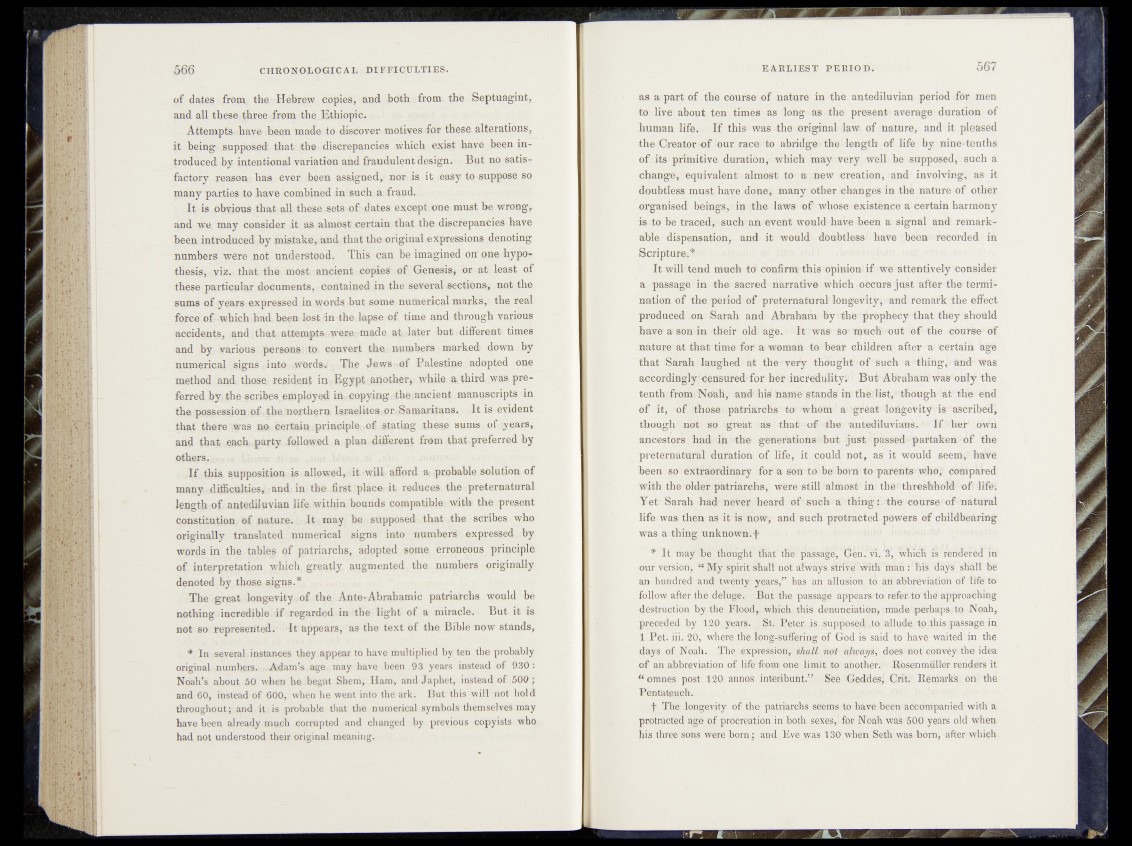
of dates from, tha- Hebrew copies, and both from the Septuagint,
and all these th4 Btbiopici s:.
Attempts have been madeuto discover1 naostiiwes^fo# these alterations,
it being- supposed tibatijthe-idiserepaneies which exist have been introduced
by intentional variation and fraudulent design. • But no satis-:
factory reason,; has, ever been assigned, nor. is it easy to suppose so
many parties to have combined in such a fraud.
It is obvious that all these.sets.-of-dates except- one must be wrong,
and we may consider it as almost certain that the discrepancies have
been introduced , by mistake, and that the .original expressions denoting
numbers were not understood. This-can be imagined on' one hypothesis,
viz. that the most ancient copies of Qenesis, or at least of
these particular documents, - contained in «the several sections, not the
sums of years expressed in words but some numerical marks,- the real
force of which had been lost in the lapse of time and through various
accidents, and that attempts-were- m^de,at.later hut.‘different times
and by various persons-;to convert the numhers marked- down by
numerical signs, into .words. . The Jews .of Palestine adapted one
method and. those, resident in7 Egypt another, while a,third was preferred
byt the scribes, employed, in. copying the janeient manuscripts in
the possession pf,the-northern- Issaelhes>or>Samaiitans. It is.evident
that thpre ewas no certain principle, ,o£ stating these sums of years,
and that* each, party -followed a plan different from that preferred by
others. .. .
. If this, supposition is allowed, it will-- afford a. probable solution of
many. difficulties, .and- in the first place, it. r.ed>uees thp-preternatural
length of antediluvian life within bounds compatible with the present
constitution of nature. It may be supposed that the scribes who
originally translated numerical signs into numbers? expressed, by
words in the tables of patriarchs, adopted, some erroneous principle
of interpretation which greatly, augmented the numbers originally,
denoted by those signs.*
The great longevity-iof the Ante-Abrahamic patriarchs would be
nothing-incredible if regarded in'the light of a miracle. But it is
not so represented. It appears, as the text of the Bible now stands,
* In -several .instances they appear to have multiplied by ten the probably
original-numbers, Adam’s,,age . may* have been 93 years instead of 930:
Noah’s about 50 when he.-begat Shem, Ham, and Japhet, instead of 500;
and 60, instead of 600, when he Went into the ark. But this will not hold
throughout; and it. is, »probable that the numerical,symbols themselves may
have been already much corrupted .and changed by previous copyists who
had not understood their original meaning,
as a part of the course of nature in the antediluvian period for men
to live about .ten times*1 as long asj thes present1» average- duration of
human life^dSs this»-was -the-JörigiinalHlaw» of nature, And'it pleased
the Qreaterajf tour racet-to abridge* the!length of life by nine-tenths
its primitive ^urationy which m&yss.very <■ well* he* ‘supposed,- such a
change, equivalent almost? to a- now creation; -and- involving, as it
doubtless must have done; maiiy other iehsdige® in the natureof other
organised beings, -in sthe laws of -w-hose existënce a certain harmony
is to be traced,- such aft event would have -been a signal and remarkable
dispensation, and it would doubtless have been recorded in
Scriptum^' *
It will-tend much to confirm- this opinion! if We attentively consider
a passage in the sacred narrative which -occurs just after1 the termination
of the period of preternatural longevity, and- remark the effect
produced on Sarah and) Abraham by-thO, ^rOpbècy*4hat thfey'sho#M
havé'a1 son* in their old age. It wa# Scr'mutA'JoUt Of^the conrse'of
nature at thatrtime for a woman to bear children after- a certain age
that Sarah laughed a/t the-very thdughtóöf'feiïeh a rthifrg/and was
accordingly'Censured for*her incredulity^ But1 Abraham v^asohly the
tenths from^Noahj and1 his name stands hi1 thésltet,s‘rfm&gh’ ^attthO^ënd
Of it, of thos©«‘patriafchs toe-whom a1'grëat‘dod^eVity‘-'is ascribed-,
though not so great as that-of-the antediluvians. ' If her own
ancestors hjad in the generations * but just1 passeibpartakenof the
preternatural duration of life, it could not, as it would seemyfaave
been soitextraordinary fora; SOnr tOibehwri'toipa^rfe'Whoy eéèipaSred
with the older'p&triarebs, were>still 1almost in theCthreShhold o f
Yet Sarah had nefcer heard of’sueh a thing s the®tcöüfse»'-of*'natural
life was then as it is nowy and such protracted pow-ers of ohilöbè&ring
was a thing unknown.f
* It may be thought' that ' the pa'SsAge, Geh.vi. 3, which is rendered at
our version; ."** My spirit shall not sfmèf'WitH 'ttra.h :?liikraslys shall fife
an hundred and twenty years,” has ah allusion, to ati ShWOviaiioh of life to
follow after the deluge. But the passage apjiëais'to* refer-to the approaching
destruction by the Flood,- which, this denuneiatioBy \made perhaps - to Noah,
preceded by 120 years. St, Btterji^uppps^jit^ 'allude*;tfeih%passage in
1 Pet. iii. 20, where the long-suffering of God is said to have waited in the
days of Noah. The expression,- 'shall not- always, d©ce=UOfc conveysthe idea
of an abbreviation of life fronr one. limit to- anotheri*1 Bfosenmüller renders it
“ omnes post 120 annos interibunl.”- See *Geddesj Crit.' Rêniartó - on the
Pentateuch.
f The longevity of the patriarchs seems to have been'accompanied with a
protracted age of procreation in both sexes^-for Noah was-SOO years old when
his three sons were bora; and Eve was 13Q.when Seth w&s born* after which